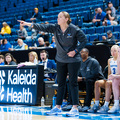SU’s starting XI has changed just twice. A switch could spur ACC improvement.

Syracuse has used the same starting lineup in 11 of 13 games, but as ACC play progresses, a change could spark improvement. Lars Jendruschewitz | Senior Staff Photographer
Get the latest Syracuse news delivered right to your inbox. Subscribe to our sports newsletter here.
A “flat-track bully” is a term derived from cricket that describes a player or team that performs exceptionally well against weaker opponents but struggles against strong ones. In the past, it has been used to label Manchester City’s Erling Haaland and other star strikers when they don’t score in big games. It also applies to Syracuse women’s soccer.
Since 2019, the Orange have won 28 games, but 25 of those victories were in nonconference play. In that span, SU has beaten just one team with more wins than them at the time of playing.
A Sunday clash with No. 3 Stanford posed a predictable test. What ended in a 4-0 loss began with the Cardinal scoring thrice in the first 10 minutes. However, with each defeat, SU head coach Nicky Thrasher Adams continues to use the same lineup.
In 11 of 13 games this season, Adams has played an identical starting XI. And as the Orange (4-5-4, 0-4-1 Atlantic Coast) remain winless in ACC play, it could be time to explore a lineup change. While Adams has made some recent shifts, they’ve been minimal and haven’t led to successful results. The head coach replaced Kendyl Lauher with Maya McDermott, who deputized at right wing back against Stanford Sunday. Anna Rupert took McDermott’s place after starting her first match against No. 1 Virginia. But that’s it.
A domino effect ensues when rotations don’t happen. Tired legs produce poor performances. Poor performances usually lead to bad results. Syracuse has had plenty of those to go around.
A hard-fought draw against SMU was followed by batterings against then-No. 7 Florida State and the top-ranked Cavaliers. Syracuse almost held on against California before Soleil Dimry’s tap-in at the 64th minute killed the Orange’s chances. Then things unraveled in Silicon Valley.

Sophia Burke | Digital Design Director
Players across other ACC squads have flourished against conference opponents. But that isn’t the case for Syracuse.
As for SU’s attack, Mia Klammer’s fifth and final season began with four goals and two assists in five games. She hasn’t scored since Sept. 7, even though she’s started in all 13 games. Ashley Rauch’s renewed attacking role led to braces against Charleston Southern and Holy Cross. Now, she’s without a goal involvement in eight games. McDermott went 38 games without scoring a goal for SU before registering a tally in back-to-back games against Canisius and Holy Cross. It’s been over a month since she found the back of the net.
Syracuse found stability through its back three of Natalie Magnotta, Bree Bridges and Jasmine Nixon ahead of its first conference match against the Mustangs. The same backline has allowed 107 shots across five conference games. Shea Vanderbosch, now the program’s saves leader with 349 saves, has conceded 13 goals in conference play, which is tied for last in the ACC alongside Clemson and Pittsburgh.
Adams and the rest of her coaching staff frequently rotate the Orange’s wingbacks. Lauher, Gabby Wisbeck, Vita Naihin and Julia Arbelaez have been Adams’ go-to on the flanks this season. Yet, Lauher only totals 407 minutes across 12 starts.
In a 3-5-2 formation, wingbacks provide both an attacking outlet and defensive cover within the same passage of play. Meanwhile, in a traditional back four, there’s more cover with the four shifting together as a collective unit to shut out the opponents’ attackers.
Once in a back three, the spaces left to cover expand, especially in transition. There’s not much room for error and Stanford exposed SU.
In the first minute, Syracuse’s very aggressive press did its job.
Wisbeck forced Stanford right back Sammy Smith to play it back to goalkeeper Caroline Birkel, who didn’t have many options ahead. She and McDermott occupied the Cardinal’s outside backs.
Anna Croyle and Rauch shut down the passing lane to Shae Harvey and Y-Lan Nguyen in the midfield while Emma Klein sat deep. Klammer and Rupert were positioned in front of Stanford’s two center backs, with Nixon and Magnotta directly behind its wingers.
But once the ball reached Birkel’s feet, Syracuse dropped off. Facing no pressure, she skipped by the Orange’s press with a long ball toward Eleanor Klinger. The Orange lost two 50-50 balls, leading to a Stanford tap-in.
Stanford’s following three goals all stemmed from SU errors. A poor clearance attempt from Nixon and a bad touch from Klein offered Stanford a second invitation to test Vanderbosch, which it took. The fourth goal was because Bridges failed to remain goalside of Jasmine Aikey, forcing Vanderbosch to leave her goal unprotected with one of the best scorers in Division I in front.
On Sept. 14, FSU substituted all 10 outfield players against SU. Two of the substitutes scored. Virginia and Stanford combined for seven goals in two matches against the Orange, with each goal scored by a different player. Syracuse hasn’t had more than one player score a goal in a game since a 3-0 win against Cornell.
Naihin, who has played over 50 minutes in four of the last five games and scored Syracuse’s sole ACC goal against SMU, is one of Adams’ most intriguing options. Abigail Incorvaia, who scored 117 goals for Waldick High School (New Jersey), Rupert, Arbelaez and Olivia Bozzo could also see increased roles.
But no matter who Adams chooses, a mix in its starting lineup before matches with 14th-place Clemson, 15th-place Miami and 13th-place Boston College could be key for the Orange to get back on a winning track.






